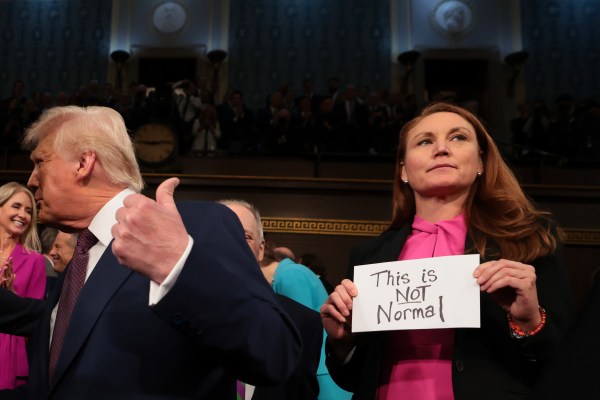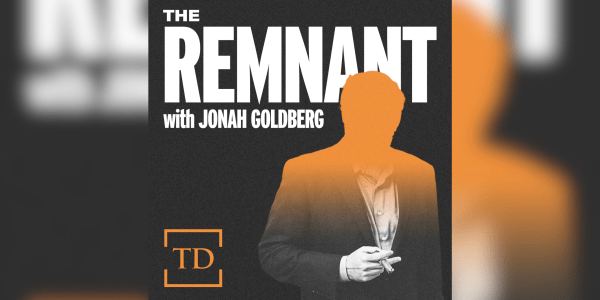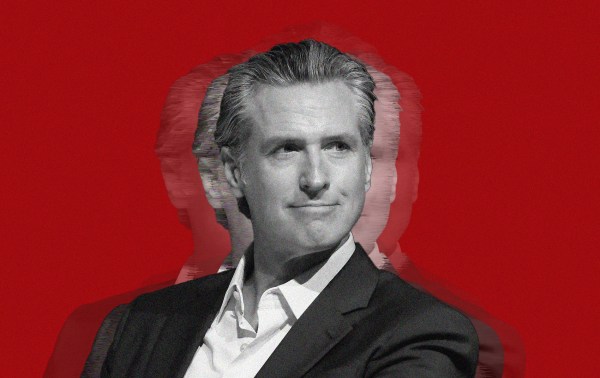Turn any article into a podcast. Upgrade now to start listening.
Premium Members can share articles with friends & family to bypass the paywall.
Kudos to Michigan Gov. Gretchen Whitmer. She managed to generate the most negatively iconic photo of a Democrat since Michael Dukakis wore a helmet atop a tank.
Whitmer, long considered a promising presidential prospect by Democratic insiders, was at the White House to discuss state business. But when Trump’s aides whisked her into the Oval Office it was not for the planned one-on-one meeting with the president, but for a photo-op during which Trump signed (outrageous) executive orders targeting two perceived political enemies for criminal investigation. Realizing that she was in a political tiger pit, Whitmer opted for the Ostrich Maneuver. Lacking sand to stick her head in, she hid her face behind some binders, as a New York Times photographer captured for posterity.
The photo perfectly encapsulates Democratic dysfunction. Her White House visit was wholly defensible, but because she was in the room when Trump was doing something indefensible, she’s being vilified by her own side for enabling Trump, generating more “Dems in disarray” drama in the process.
Of course, the Dems really are in disarray.
If you just go by the topline 2024 presidential election returns, it’s not obvious they should be. Kamala Harris lost by 1.48 percent of the popular vote, the fifth-closest election since 1900.
And yet, Democrats are a mess. In March, the party hit its all-time low in popularity. Last week—a bad week for Trump—Quinnipiac released a poll finding that voters are evenly split—33-33—on the question of which party cares more about them and their problems. Democrats had led on that question by double digits going back to 1994.
“This to me is the most shocking pieces of poll data that I truthfully have seen this year, maybe in any prior year,” CNN’s polling guru Harry Enten exclaimed.
The main driver of the Democratic Party’s plight is that it likes to see itself as the party of the little guy, but it’s perceived, not inaccurately, as the party of urban and coastal elites by the largest chunk of the electorate: white voters without a college degree. More broadly, voters remain profoundly distrustful of elite institutions, and progressives have dominated most of those institutions for decades. What the Democrats can do to fix themselves and voters’ perception is the subject of intense internal debate. At least four options have emerged.
The first is to replay the “resist!” theatrics of the first Trump term. The second is the “Fight the Oligarchy!” tour headlined by Sen. Bernie Sanders and Rep. Alexandria Ocasio-Cortez. Both approaches are psychologically appealing to Democrats because they require no philosophical introspection or political self-correction.
Not so option 3. “Abundance!” is the buzzword and book title for a technocratic theory of “supply-side liberalism” that seeks to clear away the red tape and interest-group NIMBYism standing in the way of government planners who want to expedite the delivery of public services—housing, high speed rail, etc.
This course has the most to recommend it. But it has three political weaknesses. First, the bureaucratic bottlenecks that the abundance Dems want to circumvent are closely guarded by progressive constituencies. If you want to bulldoze through the Clean Water or Endangered Species Acts, you won’t be picking fights with a lot of Republicans. You’ll be antagonizing well-heeled Democrats and a liberal-dominated media that reflexively casts such efforts in a negative light. Second, national Democrats are powerless in the Republican-controlled House and Senate. So, absent a truly courageous governor, they can’t demonstrate the efficacy of their ideas. Last, it essentially represents a bunch of elite eggheads saying, “Trust us, we’re different now” when no one trusts them.
Ironically, the fourth option is symbolically close to what Whitmer did: hide. Or, as James Carville puts it, “Play dead.” Keep your head down and powder dry while Trump self-immolates.
I think this is, by far, the wisest course in the short term. Trump’s approval, most notably on the economy, is plummeting. A majority—54 percent—of Americans think Trump’s policies are responsible for the state of the economy. If trends continue Trump will lose support from the groups that believed he could deliver on his economic promises.
The problem is the long term. Our politics are broken because both parties have given up on the idea of being majority parties. When out of power, they rely on turning out their bases and the unpopularity of their incumbent opponents to squeak out narrow victories, only to squander power on fan service to their bases once elected. This cycle can only be broken by a party that, when elected, opts to build a majority from the center out. I see no sign of that happening any time soon.







Please note that we at The Dispatch hold ourselves, our work, and our commenters to a higher standard than other places on the internet. We welcome comments that foster genuine debate or discussion—including comments critical of us or our work—but responses that include ad hominem attacks on fellow Dispatch members or are intended to stoke fear and anger may be moderated.
With your membership, you only have the ability to comment on The Morning Dispatch articles. Consider upgrading to join the conversation everywhere.